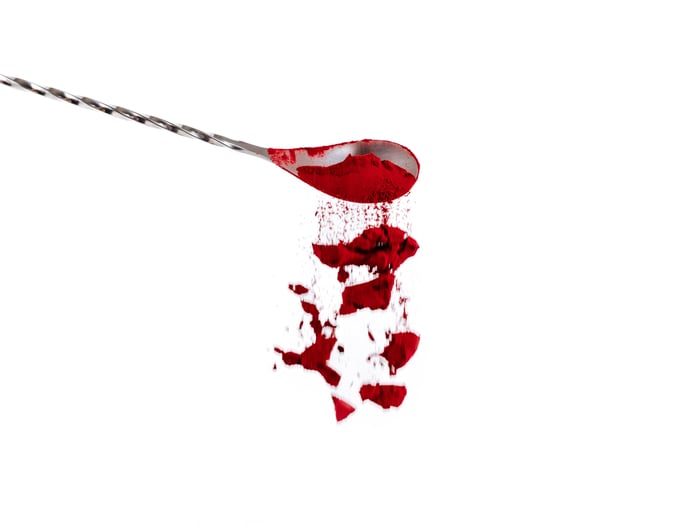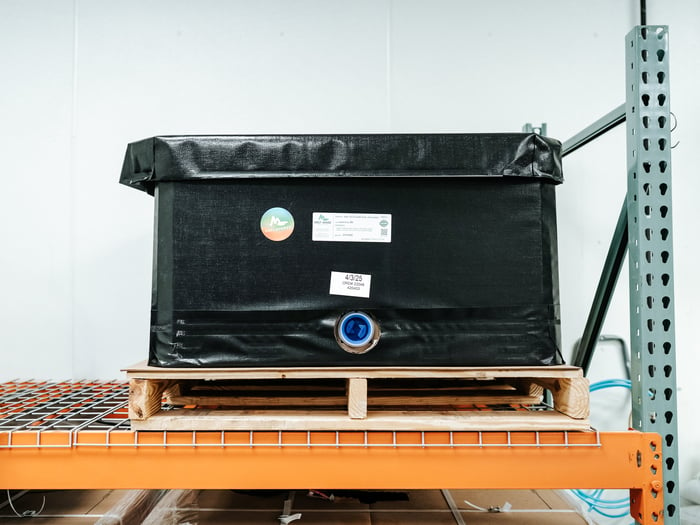Table of Contents
With Melt-to-Make’s™ pre-formulated gummy bases and our new all-natural colors, your gummy manufacturing process just got a whole lot easier!
When it comes to manufacturing gummies from scratch, the challenges can be endless—and choosing the right all-natural colors is just the beginning. That’s why we’re excited to introduce our newest lineup of all-natural powdered colors: Natural Red, Natural Yellow, Natural Purple, Natural Pink and Natural Blue!
Each one is vibrant, plant-based, and specifically formulated to pair perfectly with Melt-to-Make™ Gummy Bases. With these new additions, achieving eye-catching, clean-label gummies has never been easier.
265 g (9.3oz) Melt-to-Make™ Natural Red Color

$50.00
Bring Your Gummies to Life—NaturallyCrafted from all-natural ingredients, our Natural Red Color delivers a vibrant hue to your gummy creations—without relying on artificial dyes. This all-natural red color is derived from elderberries. At our recommended usage rate of 0.15 -… read more
340 g (12 oz) Melt-to-Make™ Natural Yellow Color

$50.00
Bring Your Gummies to Life—NaturallyCrafted from all-natural ingredients, our Natural Yellow Color delivers a vibrant, appetizing hue to your gummy creations—without relying on artificial dyes. At our recommended usage rate of 0.02–0.2%, one jar provides enough color to manufacture approximately:… read more
280 g (9.9 oz) Melt-to-Make™ Natural Purple Color

$70.00
Bring Your Gummies to Life—NaturallyCrafted from all-natural ingredients, our Natural Purple Color delivers a vibrant hue to your gummy creations—without relying on artificial dyes. At our recommended usage rate of 0.2 - .0.6%, one jar provides enough color to manufacture… read more
265 g (9.9oz) Melt-to-Make™ Natural Pink Color

$55.00
Bring Your Gummies to Life—NaturallyCrafted from all-natural ingredients, our Natural Pink Color delivers a vibrant hue to your gummy creations—without relying on artificial dyes. At our recommended usage rate of 0.02–0.2%, one jar provides enough color to manufacture approximately: • 170… read more
265 g (9.4oz) Melt-to-Make™ Natural Blue Color

$40.00
Bring Your Gummies to Life—NaturallyCrafted from all-natural ingredients, our Natural Blue Color delivers a vibrant hue to your gummy creations—without relying on artificial dyes. At our recommended usage rate of 0.5 - 1.0%, one jar provides enough color to manufacture… read more
Powdered Color Bundles
Our Melt-to-Make™ Powdered Color Bundles are designed to give you maximum flexibility and creativity in your gummy production. With just a few base colors, you can create a wide range of custom shades to perfectly match your brand or product line.
For example, with our Blue + Yellow Bundle, you can easily blend to make a vibrant Green. Or, with our Red + Yellow Bundle you’ll get a bold Orange. These bundles make it simple to expand your color palette without needing to purchase every single color individually.
It’s an easy, cost-effective way to customize your gummies while keeping your process efficient and streamlined.
The Reason Behind the Melt-to-Make™ All-Natural Color Launch
Uncolored & Unflavored Melt-to-Make™ Gummy Bases | Buying in Bulk
The launch of Melt-to-Make™ All-Natural Colors was driven by our commitment to giving gummy manufacturers more flexibility, control, and clean-label options. Pairing these plant-based colors with our Uncolored & Unflavored Melt-to-Make™ Gummy Bases allows you to fully customize both the look and taste of your products while maintaining consistency and quality. And by offering these colors in bulk, we’re making it easier and more cost-effective for you to scale production without compromising on vibrancy or ingredient integrity.
Melt-to-Make™ 550 kg Classic Pectin Totes & Sugar-Free Pectin Totes
This is especially valuable for those working with our 550 kg Classic Pectin Totes and 500 kg Sugar-Free Pectin Totes, which currently come in unflavored and colored pectin — making our new all-natural bulk colors the perfect companion for full customization, and large gummy manufacturing operations
How to Use Melt-to-Make™ All-Natural Colors
Our all-natural colors were designed and tested specifically to work seamlessly with Melt-to-Make™ gummy bases, giving you vibrant, consistent results every time. That means no guesswork, no wasted batches—just bold, beautiful gummies that shine. To get the best results, be sure to follow this step-by-step guide, which walks you through how to properly mix, measure, and incorporate our colors into your Melt-to-Make™ gummy base.
Melt-to-Make™ Color Usage Guide
From Synthetic to All-Natural Colors: Making the Switch with Melt-to-Make™
As the FDA takes steps to phase out petroleum-based synthetic food dyes, gummy manufacturers are racing to reformulate with naturally sourced alternatives. And while natural colors come with big benefits—like clean-label appeal and consumer trust—they also bring technical challenges that require smart R&D.
It’s not just a matter of swapping one pigment for another. Successful reformulation demands a deeper understanding of stability, sourcing, pH sensitivity, and heat tolerance.
At Melt-to-Make™, we’ve been using all-natural colors in our gummies since day one. It took hundreds of hours in the lab, years of shelf-life testing, and lots of trial and error to find the most reliable pigments on the market. We’ve done the hard work—so you don’t have to. And now, we’re sharing what we’ve learned.
What’s the Difference Between Natural and Synthetic Colors?
All-Natural Colors
All-Natural colors come from all the good stuff - fruits, veggies, spices, flowers, even algae. Think elderberry juice, turmeric, spirulina, butterfly pea flower, sweet potatos and purple carrots.
Synthetic colors
Synthetic colors on the other hand, are made in a lab from petroleum or coal tar (yep, kind of gross). These are your FD&C colors like Red No. 40, Yellow No. 5, and Blue No. 1. Why are synthetics still around? Because they’re cheap, reliable, and super stable in almost any environment. But the tide is turning: more consumers want ingredient lists they can actually pronounce, and natural colors—when done right—can be just as vibrant and much more consumer and environmentally friendly.
Making the Switch: What You Need to Know
Here’s a quick look at what it takes to go from synthetic to natural colors in your gummies.
1. Source with Smarts
Not all colorants are created equal. Skip the DIY grocery aisle approach—work with reputable suppliers who know food manufacturing and specifically gummies inside and out. Many require large minimum order quantities, so Melt-to-Make™ is now offering smaller containers of some of the best colors available on the market. They come with usage guidelines and color charts and work seamlessly with Melt-to-Make™ Unflavored gummy bases.
2. pH Troubleshooting
Natural colors are pH-sensitive—they can shift hue based on your formulation’s acidity.
Most gummies fall in the 3.2–3.8 pH range, which is ideal for microbial stability and gelling. We’ve carefully selected pigments that hold up beautifully in this range, delivering bright, reliable color every time.
3. Check the Heat
Making gummies means turning up the heat:
- Gelatin-based: ~150–170°F
- Pectin-based: ~190–230°F
Some natural colors—like phycocyanin (the pretty blue from spirulina)—can’t take the heat and will degrade quickly above 160°F. For this reason this color can not be used in a pectin gummy without turning a brownish green, but can be used in a gelatin gummy formulation. Other natural colors, like curcumin (from turmeric), are incredibly stable at higher temperatures. The bottom line is to know what you are working with, and understand the limitations of each pigment.
4. Storage Smarts
Even after production, natural colors are sensitive. Exposure to oxygen, moisture, and light can dull their shine. Here’s how to protect your gummy masterpiece:
- Dry to a water activity of 0.60–0.67
- Store in a cool, dark place
- Use opaque or UV-blocking packaging
- Run real shelf-life tests to see how your color will hold up over time
At Melt-to-Make™ we have done all this testing for you, so as long as you follow the recommendations, you can use our colors with confidence.
Melt-to-Make™ Natural Powdered Colors and Their Stability Profiles
Custom Blends made with Melt-to-Make Colors
A Few More Nuggets to Keep in Mind
Labeling:
Natural colors need to be called out by their source—no more hiding behind numbers. So it's “Turmeric (Color)” not “Yellow 5.”
Regulatory Wave:
The FDA’s ban on Red Dye No. 3 kicks in by 2027, and over 20 states are lining up with their own bans and restrictions on artificial dyes. The message is clear: start reformulating now or risk scrambling later.
What Consumers Want:
People want transparency. And they’re willing to pay for it. Natural colors support premium pricing and build trust—especially with health-conscious parents and wellness-savvy shoppers.
Final Thoughts
Swapping synthetic colors for natural ones isn’t just a trend—it’s part of a bigger move toward transparency, sustainability, and consumer trust. Yes, it takes more R&D. Yes, it can be a bit finicky. But once you’ve got your formula locked in, you’ll have a gummy that’s not just tasty, but also clean, marketable, and future-proof.So go ahead, embrace the rainbow, we’re here to help every step of the way.
FAQs
How do I use Melt-to-Make™ All-Natural Colors?
Follow the Melt-to-Make™ Color Usage Guide
Where can I purchase Melt-to-Make™ All-Natural Colors?
What's the difference between all-natural colors and synthetic?
All-Natural colors come from all the good stuff - fruits, veggies, spices, flowers, even algae. Think elderberry juice, turmeric, spirulina, butterfly pea flower, sweet potatos and purple carrots.
Synthetic colors on the other hand, are made in a lab from petroleum or coal tar (yep, kind of gross). These are your FD&C colors like Red No. 40, Yellow No. 5, and Blue No. 1.
Why are synthetic colors still around?
Because they’re cheap, reliable, and super stable in almost any environment. But the tide is turning: more consumers want ingredient lists they can actually pronounce, and natural colors—when done right—can be just as vibrant and much more consumer and environmentally friendly







